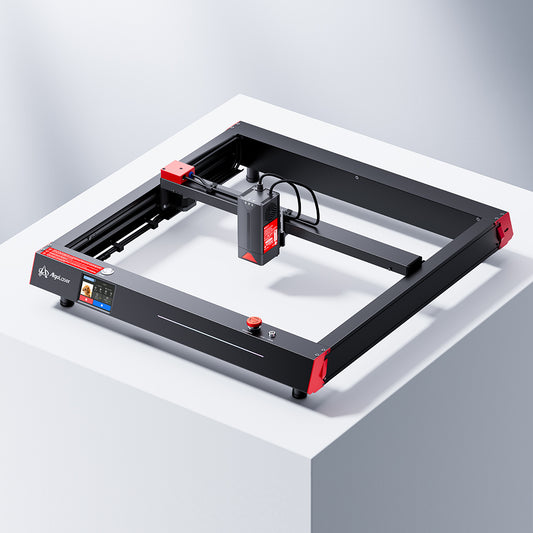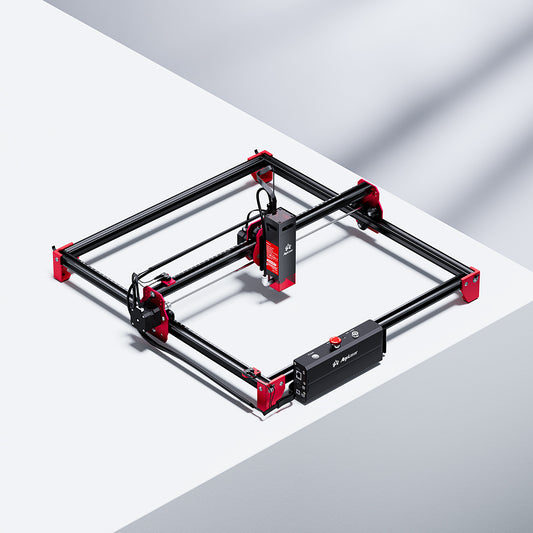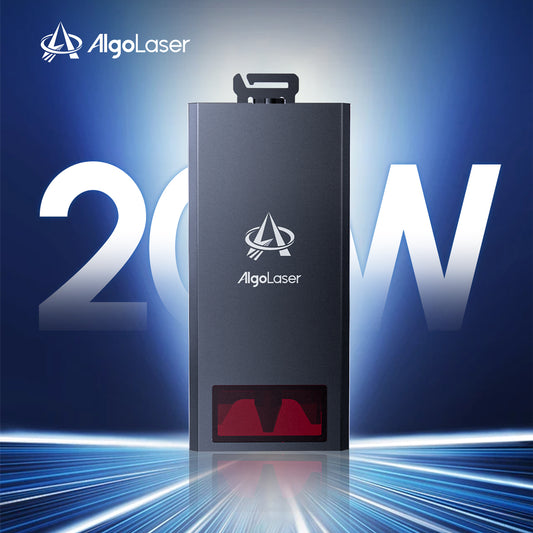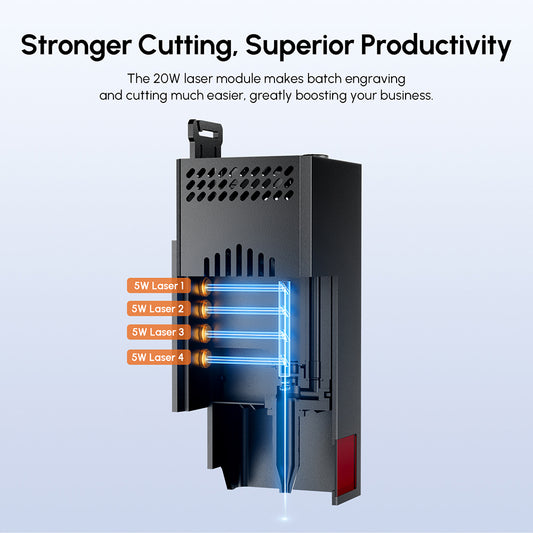Afraid of Complex Software? Here's How to Start Laser Engraving the Easy Way!
If you've ever dreamed of starting your laser engraving journey but felt intimidated by complex software or large, industrial-looking machines, the AlgoLaser Pixi 10W might be the perfect entry point. Compact, intuitive, and ready to go right out of the box, this little diode laser engraver proves that creativity doesn't have to come with confusion.
In this detailed review, we'll walk through the full user experience — from unboxing and first projects to exploring advanced features with LightBurn and even integrating AI-generated designs. Whether you're a hobbyist, crafter, or tech geek, you'll see how easy and fun the Pixi makes it to bring your ideas to life.
1. First Impressions: Small Size, Big Potential
At first glance, the AlgoLaser Pixi 10W looks almost toy-sized — but don't let that fool you. With a 10 × 10 cm engraving area, it's designed for compact projects like wooden coasters, cutting boards, name tags, and plant markers. The frame is partly plastic to keep it lightweight, but the essential components like the laser module mounts and base plate are sturdy metal.
Out of the box, the Pixi comes fully assembled, so setup takes just minutes. You simply remove the foam packaging, peel off protective films, and plug it in. No tools, screws, or confusing calibration steps — it's plug and play.
My first impression? For beginners, this is exactly what you want: zero intimidation, instant creativity. It's not the most powerful laser engraver on the market, but it's easily one of the most user-friendly.
2. The First Hiccup: SD Card Issues (and Fast Support)
No tech review is complete without a hiccup, right? In this case, the included SD card wasn't recognized correctly on first use. But credit where it's due — AlgoLaser's customer support responded quickly, acknowledged the issue, and even sent out a replacement. I temporarily swapped in my own SD card, following their clear guide, and was back to engraving in no time.
This is exactly the kind of responsive customer service beginners need — when your first project hits a snag, you want solutions, not silence.
3. Safety and Ventilation: Don't Skip This Part
Laser engraving involves burning or etching materials like wood, leather, or coated plastics, which naturally produces smoke and fumes. The Pixi includes a built-in exhaust fan and an air hose, but it's not as powerful as an industrial extractor.
You'll definitely want to operate it near a window, in a garage, or with an additional ventilation setup. In my case, I 3D printed some adapters to extend the hose and direct it outdoors — a perfect example of how the DIY community can enhance even entry-level tools.
Remember: proper ventilation isn't optional. It's essential for both health and performance.
4. Laser Engraving Without a Computer: Easy and Fun
Now for the part that really impressed me — you don't need a PC or complicated software to start engraving.
The AlgoLaser Pixi runs AlgoOS, a smart onboard system that lets you select designs, fonts, and preset materials directly from the touchscreen. You can create simple text engravings, use built-in templates, or even draw your own designs right on the screen.
In just a few minutes, I engraved text on wooden plant markers, etched a logo on a bamboo cutting board, and created small wooden coasters — all without ever connecting to a computer. This is a game-changer for beginners who want to focus on creativity, not configuration.
You can even use the AlgoLaser mobile app for quick edits or wireless control — perfect if you want to engrave something spontaneous from your phone.
5. Safety First: Real Protection Built In
Despite its compact size, the Pixi includes serious safety features. The machine automatically pauses when you open the lid, preventing laser exposure. There's also a PIN lock screen to stop children or curious guests from accidentally activating it.
It's certified as a Class 1 laser product, meaning it's designed to be safe for home and classroom use when operated properly. A tilt sensor also shuts off the laser if the machine tips over during operation — a thoughtful touch that adds peace of mind.
6. Stepping Up: Using LightBurn for Advanced Projects
Once you're comfortable with the basics, it's time to explore the real power behind the Pixi: LightBurn.
LightBurn is a professional-grade laser software that lets you create layered designs, fine-tune engraving speeds and power levels, and even control the Pixi wirelessly via Wi-Fi. You don't even need to connect a USB cable — just enter the Pixi's IP address, and you're good to go.
Setup is simple:
1. Find your Pixi's IP address on its display.
2. Add a new device in LightBurn → choose GRBL via Ethernet.
3. Enter your IP, name the device, and set your work area to 100 × 100 mm.
4. Done! You can now move the laser, test positions, and start engraving.
LightBurn also supports layer-based workflows, meaning you can engrave text on one layer, cut outlines on another, and adjust settings for each. It's professional-grade flexibility — without the steep learning curve.
7. Turning AI Images into Laser Designs
One of the coolest moments in this test was converting AI-generated artwork into real, engraved creations.
Using LightBurn's "Trace Image" feature, I imported a black-and-white AI logo (think minimalist mountains and trees) and converted it to vector lines suitable for laser engraving. In just a few clicks, the software detected the edges, filled the shapes, and prepared it for cutting or engraving.
This combination of AI art + laser engraving opens endless creative possibilities — from custom gifts and coasters to branding marks and décor. Whether you're using Midjourney, DALL·E, or any other generator, LightBurn makes it easy to turn digital imagination into tangible designs.
8. Material Testing: Finding the Perfect Settings
Every laser engraver behaves differently depending on material type, density, and surface finish. LightBurn includes a "Material Test" feature that lets you automatically generate a grid of speed and power combinations. After engraving the test grid, you can visually identify which settings deliver the best contrast or cleanest cut.
For example:
| Material | Power (%) | Speed (mm/min) | Result |
|---|---|---|---|
| Bamboo | 35 | 3000 | Crisp, dark engraving |
| Birch Plywood | 40 | 2500 | Slightly deeper burn |
| Cork | 25 | 4000 | Soft but visible contrast |
| Acrylic (coated) | 60 | 2000 | Sharp lettering, no melt |
This testing process is part of the fun — a mix of art and science that helps you understand your laser's behavior.
9. 3D Printing Upgrade: Positioning Perfection
Because the Pixi doesn't have built-in corner guides, I designed a 3D-printed positioning bracket to ensure consistent alignment. This simple add-on fits snugly into the lower-left corner of the laser bed, so I can place materials in exactly the same spot every time — perfect for batch engraving or repetitive logos.
It's another reminder that the maker ecosystem thrives on creativity: combine 3D printing, AI design, and laser engraving, and your workshop becomes a true innovation lab.
10. Verdict: Who Is the AlgoLaser Pixi For?
After testing, here's my honest takeaway:
✅ Perfect for beginners. Simple setup, intuitive controls, and built-in projects make it ideal for first-timers.
✅ Portable and quiet. Small footprint, easy to move, and reasonably quiet operation.
✅ Versatile enough to grow with you. Start simple, then advance to LightBurn and AI-based projects.
⚠️ Limited work area. 10 × 10 cm is fine for small crafts but restrictive for large projects.
⚠️ Ventilation could be stronger. Use near a window or add your own exhaust fan for safety.
If you're new to laser engraving and want something affordable, educational, and fun, the AlgoLaser Pixi is a fantastic choice. It removes the fear of complexity while still leaving room to explore deeper features as your confidence grows.
Final Thoughts:
Laser engraving doesn't have to be complicated. With machines like the AlgoLaser Pixi, you can jump right in, experiment freely, and create personalized gifts, décor, or prototypes without ever touching "scary" software. And when you're ready, LightBurn and AI tools are waiting to unlock your next level of creativity.
Whether you're engraving a bamboo coaster or turning AI art into a wooden masterpiece — the Pixi laser engraver makes it all possible, one beam at a time.





